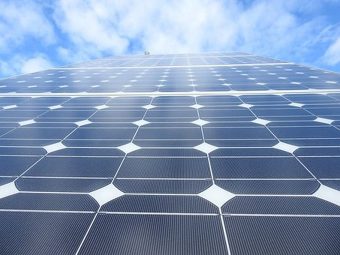
China, the world’s biggest investor in clean energy, is on pace to install record amounts of new solar this year after adding 24 gigawatts of capacity in the first half amid a push by policy makers to locate electricity production near the point where it’s used.
Distributed solar-power projects — the kind of solar found on industrial buildings, malls and schools — accounted for almost a third of the new installations in the period, or 7 gigawatts, Xing Yiteng, deputy section chief in the new energy division at the National Energy Administration, said Wednesday at a conference in Beijing.
Should China maintain the first half’s torrid pace of installations, the country would easily surpass the roughly 30 gigawatts of new solar capacity it added in 2016. The continued expansion also extends China’s lead as the largest market in the world measured by the number of panels. China’s additions in the first six months of the year alone are equal to more than half of the total installed solar base in the U.S. at the end of 2016, according to data compiled by Bloomberg New Energy Finance.
“Natural demand is ramping up along with declining solar costs and the improved returns of power stations,” Alex Liu, China utilities and renewable energy analyst at UBS Securities, said in a note.
China’s demand momentum is expected to continue in the third quarter, he said.
It’s not just about installing an ever-increasing number of solar panels. Electricity output from photovoltaic plants rose 80 percent in the first quarter, the National Energy Administration said in May.
GCL-Poly Energy Holdings Ltd., the world’s biggest solar-wafer maker, surged as much as 6.8 percent in Hong Kong trading on Wednesday. LONGi Green Energy Technology Co. gained as much as 7.6 percent in Shanghai, while China Singyes Solar Technologies Holdings Ltd. rose as much as 7.3 percent in Hong Kong.
The growth in distributed solar-power projects stands to help manufacturers led by JinkoSolar Holding Co. and Trina Solar Ltd. weather a slump in demand for bigger projects far from cities, where a lack of grid connections and a flood of new projects has prompted regulators to seek slower growth from that part of the industry.
About 7 percent of China’s solar-power generation was idle in the first half, down 5 percentage points from a year earlier, Xing said, signalling that more capacity is linking up to the grid.
The nation could add more than 30 gigawatts of new solar capacity in 2017, though the market could face slower growth in subsequent years, Wang Bohua, secretary general of the China Photovoltaic Industry Association, told the same conference on Wednesday.
China installed a record 30 gigawatts of capacity in 2016, with most in the form of large-sized photovoltaic projects, according to data compiled by BNEF. The NEA puts last year’s additions at 34.54 gigawatts.
Clean-energy spending in China totaled $87.8 billion in 2016, BNEF said in a report published in January.
Source: bloomberg.com

